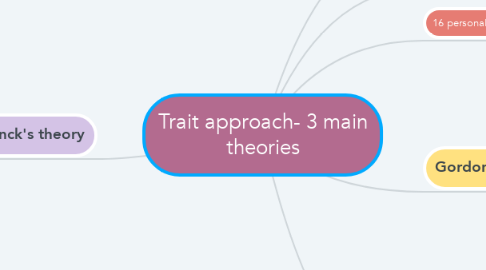
1. Source traits - Stable, and are considered as the building blocks of personality. Described in terms of opposing tendencies
2. Used for the assessment of personality.
3. 16 personality factor questionnaire
4. Gordon Allport's theory
4.1. Individuals possess a number of traits which are dynamic in nature. Bridge with features of personality
4.2. Secondary traits- Least generalized characteristics (quirks) e.g. likes mangoes
4.3. Cardinal traits-highly generalized dispositions e.g. Gandhian traits
4.3.1. They indicate the goal around which a person's entire life seems to revolve.
4.4. Central traits - highly generalized but still less pervasive (dominant) e.g. warm, sincere, intelligent
4.4.1. Often used in writing testimonials or job recommendations
5. Raymond Cattell: Personality Factors
5.1. Factor analysis - To discover common structures Bridge with Charles Spearman's 2-factor theory of Intelligence
5.2. Surface traits - Are a result of the interaction of source traits
6. Eysenck's theory
6.1. Eysenck Personality Questionnaire
6.1.1. test used for studying these dimensions of personality.
6.2. Neuroticism vs emotional stability
6.2.1. It refers to the degree to which people have control over their feelings
6.2.1.1. neurotic: anxious, moody, restless
6.2.1.2. emotional stability : calm, even tempered, reliable, have control over emotions
6.3. Extraversion vs introversion-
6.3.1. It refers to the degree to which people are socially outgoing or socially withdrawn.
6.3.1.1. (extraversion)- active, gregarious, impulsive and thrill-seeking.
6.3.1.2. introversion- passive, quiet, cautious and reserved.
6.3.2. Bridge with Jungian Typology
6.4. Psychotism vs sociability
6.4.1. hostile, egocetric, antisocial
6.4.2. It is considered to interact with the other two dimensions ie extraversion vs introversion and neuroticism vs emotional stability.
